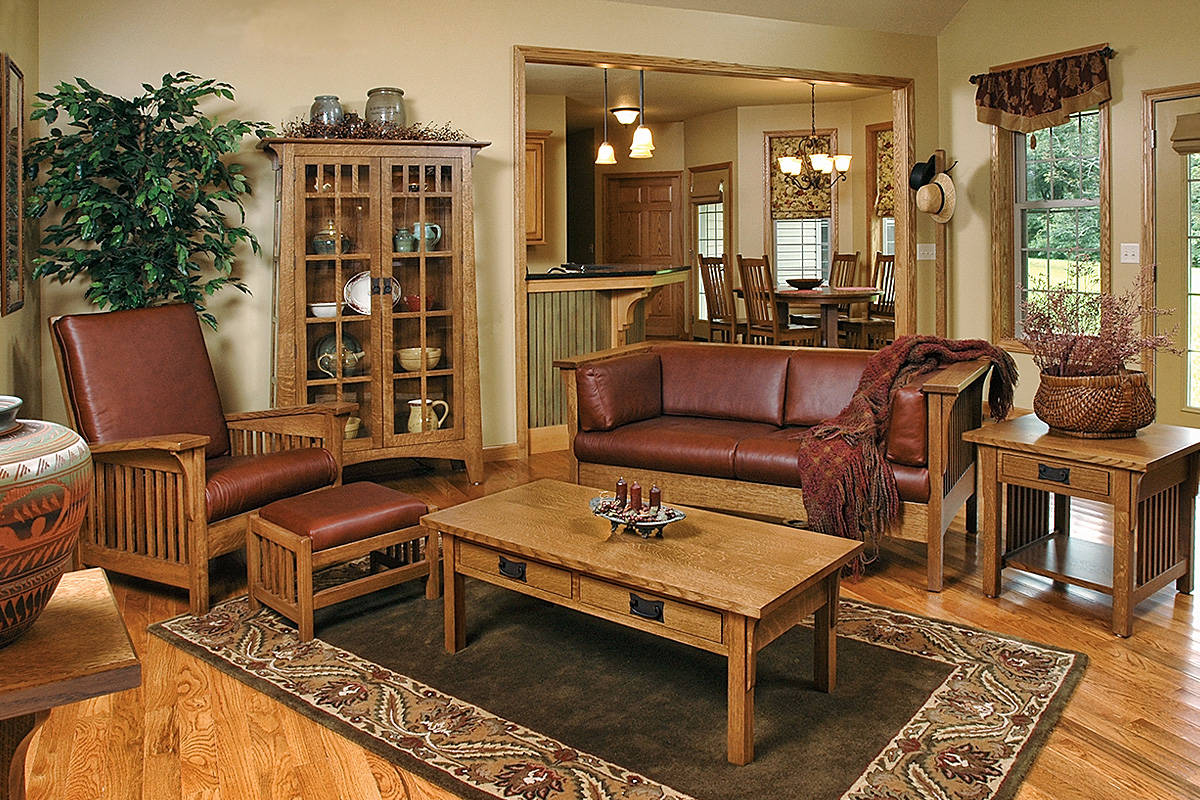


(Gustav Stickley himself made quadrilinear posts from quarter-sawn oak veneer mitered and glued around a central post.) Many highly sought-after pieces make use of veneers, hand-carving, and inlays. Not every piece of Mission-style furniture is constructed solely of solid wood.

In less expensive furniture, these details may not be integral to the construction-except, occasionally, in expensive Greene & Greene-style furniture, where in some cases exposed ebony pegs and splines are indeed purely decorative. Through tenons are often finished with pegged dowels, also a characteristic decorative element. Common on chair arms, rocking and Morris chairs, picture frames, mirrors, and tabourets, a through tenon is somewhat self explanatory: The tenon extends all the way through the mortised piece (say, the chair leg connected by a tenon from a side rail) and projects through slightly on the other side. Other techniques are similarly chosen for their ability to add strength and longevity: dovetail joinery on drawers and cross rails, center guides and non-plastic side suspension for drawers, hand-cut knobs for doors and drawers.ĭetails on Stickley’s ‘Tsuba’ Morris chair include incised carving, ebony pegs, and cloud-lift styling.Įarly Arts and Crafts practitioners turned several of these age-old interlocking techniques into signature “quaint” decorative elements, like the through tenon. “This type of joinery has been used for hundreds of years and is the reason that 100-year-old Arts & Crafts pieces are still in use today,” says Tedd Colt of Caledonia Studios. They’re also sometimes glued, although a well-constructed joint shouldn’t require it. Mortise and tenon joints are often pinned with dowels so they won’t shift as the wood shrinks and swells. Well-constructed Arts and Crafts furniture is made using mortise-and-tenon joinery-where a projecting tenon fits perfectly into a mortise opening-say, where a leg meets a crossbar-with as little nailing and gluing as possible. Keep in mind that wood selection is an art: the better the artisan, the better the matching and wood selection for the most prominent faces.īook-matched end pieces cut from the same flitch open to show the radiating grain in this side table from Cold River Furniture. Less expensive furniture in the style may not be quarter-sawn, or may be constructed from red oak rather than white. In a piece like a Morris chair or a bed frame, for example, the wood should show both a tight grain and the characteristic flecks or rays. Quarter-sawing is a cutting method that results in boards less likely to crack, check, or warp than other cuts it also reveals the beautiful flecks or rays in the grain so characteristic of Arts and Crafts furniture. The Art of Wood SelectionA large part of the appeal of Arts and Crafts furniture comes from its reliance on easily identified and naturally strong woods, like American cherry and quarter-sawn white oak. Mackintosh in his Arts and Crafts furniture design. Of course, true rarities by Charles Rohlfs or Harvey Ellis can and do sell for tens of thousands of dollars.ĭetail of the cherry ‘Glasgow’ desk by Kevin Rodel, who sometimes channels Scots designer C.R. That’s not to mention vintage and antique Craftsman furniture, where a solid but unsigned slat-back side chair good for another generation of use might sell for $150-a fraction of the cost of a well-made reproduction. Master craftsmen and -women create their own interpretations of chairs and sideboards in the style of the brothers Charles and Henry Greene, sometimes at prices that seem fantastic yet which barely cover the cost of making them, considering materials and labor. Esteemed manufacturers like Stickley turn out quality wood and upholstered pieces for every room in the house. One-man shops put together respectable end tables and desks at modest prices. The nation is awash in quarter-sawn oak furniture. This Arts and Crafts style oak dresser from Caledonia Studios reveals beautiful rays and flecks, as well as a deep patina hand-applied by the artist. If you simply want your children to have a place to sit, eat, sleep, and study, affordably made reproductions-maybe even affordable vintage pieces-make the most sense. How do you determine what’s worth buying? If the goal is to build a legacy collection of Arts and Crafts furniture to hand down to your children, look for the best you can afford, old or new. When it comes to buying Arts and Crafts furniture, prices are all over the map.


 0 kommentar(er)
0 kommentar(er)
